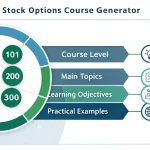Stock and Options Trading Guide Generator
Is this tool helpful?
How to Use the Stock and Options Trading Guide Generator Effectively
Follow these simple steps to create a customized trading guide tailored to your needs:
- Additional Topics (Optional): Enter specific subjects you’d like included in your guide. For example, you might enter “Momentum trading techniques” or “Tax implications of options trading.”
- Target Audience Experience Level: Choose the level of expertise your audience has. Options include “Beginner,” “Intermediate,” or “Advanced.” For instance, you could select “Advanced” if your guide targets knowledgeable traders seeking complex strategies.
- Preferred Guide Format (Optional): Select the format that suits your learning style. Examples include “Detailed case study” or “Interactive webinar series.”
- Click the Generate Guide button to produce your personalized stock and options trading guide.
After the guide appears, you can review it and copy the text to your clipboard for easy reference or sharing.
What the Stock and Options Trading Guide Generator Offers
This tool creates detailed, customized educational content on stock research and options trading. It adapts the information to your specified experience level and topics, helping traders like you build knowledge efficiently and confidently.
Purpose and Benefits
- Personalized Learning: Get trading guides that focus on the subjects you care about and match your skill level.
- Wide Coverage: Explore essential areas such as technical analysis, options strategies, risk management, and market psychology.
- Time Savings: Avoid searching different resources. The guide consolidates knowledge into one clear, concise document.
- Flexible Formats: Choose how you want to receive your guide, whether a blog post, eBook, video course, or tutorial series.
- Up-to-Date Information: Access fresh insights that reflect current market trends and trading practices.
Who Can Benefit?
Whether you are just starting out, sharpening your skills, or mastering advanced trading techniques, this tool creates guides suited to your level:
Beginners
- Learn basic concepts like stock valuation and options fundamentals.
- Understand key metrics, such as the Price-to-Earnings ratio, with simple explanations.
Intermediate Traders
- Explore practical strategies like covered calls and protective puts.
- Refine tactics for income generation and risk management.
Advanced Traders
- Dive into complex approaches such as delta neutral trading and volatility arbitrage.
- Gain insights on balancing multiple positions and advanced options greeks.
Practical Applications of the Trading Guide Generator
This guide generator helps you apply trading knowledge through real-world examples and actionable strategies.
Example Scenario: Fundamental Stock Analysis
You want to compare two companies to identify a promising investment:
| Metric | AlphaTech Inc. | BetaSystems Ltd. |
|---|---|---|
| P/E Ratio | 20 | 12 |
| Return on Equity (ROE) | 15% | 25% |
| Debt-to-Equity Ratio | 0.7 | 0.4 |
| Revenue Growth (YoY) | 8% | 20% |
- BetaSystems shows a lower P/E ratio, suggesting it may be undervalued.
- Its higher ROE indicates stronger profitability relative to shareholders’ equity.
- A lower debt-to-equity ratio signals a more stable financial position.
- Faster revenue growth points to better future prospects.
Based on this analysis, BetaSystems may be a better investment candidate. The guide recommends further research into factors such as management quality and market competition before deciding.
Example Strategy: Protective Put for Risk Management
Suppose you hold 100 shares of OpsTech, trading at $100 per share, and want to protect against a price drop in the next six months:
- Purchase 1 put option contract with a strike price of $90, expiring in 6 months.
- Put option premium is $4 per share.
The total cost of protection equals 100 shares × $4 = $400.
- If OpsTech stays above $90, the put expires worthless but your shares keep their value.
- If the stock falls below $90, the put option gains value, offsetting stock losses.
The break-even price combining stock purchase and option cost is:
$$ \text{Break-even Price} = 90 – 4 = 86 $$This limits your downside risk while maintaining upside potential if the stock rises.
Frequently Asked Questions (FAQ)
How often should I update my trading strategies?
Review and adjust your strategies every 3 to 6 months or after significant market changes to stay aligned with evolving trends.
Can I apply the same strategies to both stocks and options?
Some principles overlap, like risk management, but options require unique approaches because of their complexity and leverage effects.
Important Disclaimer
The calculations, results, and content provided by our tools are not guaranteed to be accurate, complete, or reliable. Users are responsible for verifying and interpreting the results. Our content and tools may contain errors, biases, or inconsistencies. Do not enter personal data, sensitive information, or personally identifiable information in our web forms or tools. Such data entry violates our terms of service and may result in unauthorized disclosure to third parties. We reserve the right to save inputs and outputs from our tools for the purposes of error debugging, bias identification, and performance improvement. External companies providing AI models used in our tools may also save and process data in accordance with their own policies. By using our tools, you consent to this data collection and processing. We reserve the right to limit the usage of our tools based on current usability factors.







